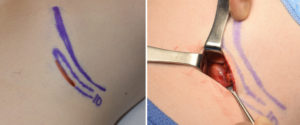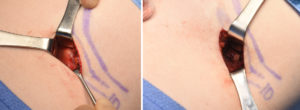Background: The ribcage is an arrangement of curved rib segments that covers much of the trunk and is a lot more complex than a static image of it appears. The curved rib bones interface with the vertebrae in the back with joint-like articulations and curve around the body to eventually connect to the bony sternum. These curved bony rib segments transform into cartilage at various levels of the twelve ribs before they connect to the sternum through a fixed bone-cartilage junction.
While traumatic injuries are well known to cause bony rib fractures, injuries to their connection points are less well appreciated. The cartilage segments of the ribs are also susceptible to trauma as cartilage is less rigid than bone and can be dislocated from their connection points. This can cause subluxation of a rib cartilage segment whose mobility or angulation can be a source of pain.
Making the diagnosis of rib subluxation or dislocation is not always easy. Cartilage does not appear as well defined on CT scans or MRIs and these also represent static images whereas such rib alignment issues may only appear in certain positions or with movement. Physical examination with well localized point tenderness may be the most definitive method of making the diagnosis.
Case Study: This young male sustained a traumatic injury to his left lower ribcage after which he had sustained pain under the left subcostal rib margin. He went through multiple methods to diagnosis the source of his chest wall pain including CT scans and MRIs which were negative. Palpation revealed a very specific point tenderness over a prominent cartilaginous tip of rib #10.

The cartilage segments of ribs, on the one hand, offer resistance to traumatic injury because they are more flexible than bone. Conversely their anterior and posterior connection/articulation points can become separated leading to mobility and rib segment angulation changes. Removal of the mobile or dislocated rib segment would be the treatment for this diagnosis.
Case Highlights:
1) Traumatic injuries can case rib deformities such as dislocations and subluxations which are more prone at the bony-cartilage junction.
2) Cartilage deformities of the subcostal ribs may not always be seen on CT scans and MRIs, physical examination may provide the most accurate diagnosis.
3) Direct resection of the deformed cartilaginous rib segment is the cure for pain caused by bone-cartilage rib dislocation.
Dr. Barry Eppley
Indianapolis, Indiana





